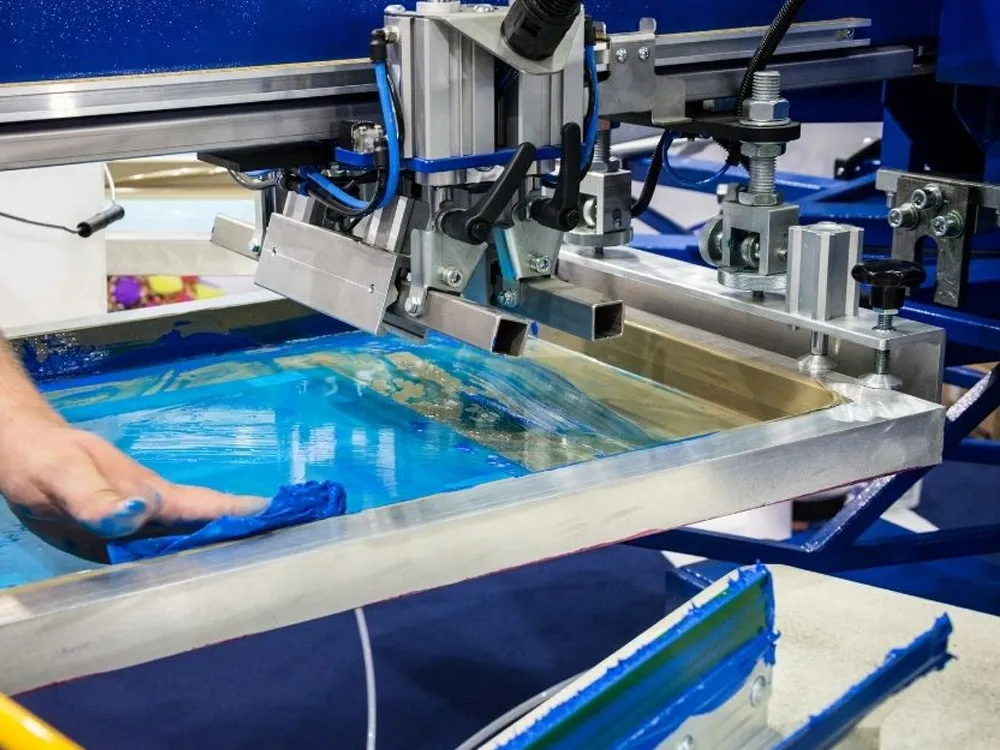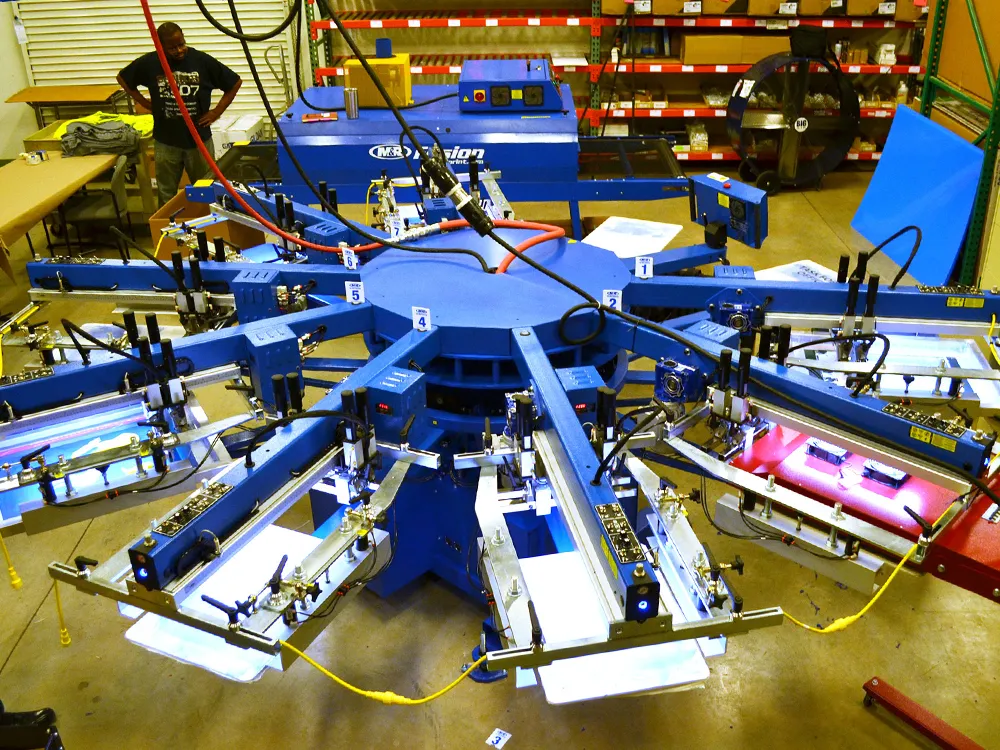Screen printing is one of the oldest printing techniques. It involves transferring artwork to a material using a stenciled mesh screen. For a long time, the apparel industry has used screen printing techniques to brand items for corporates and individuals. But in the recent past, this technique has made its way into other sectors. Including branding wooden and metallic surfaces.
You can use either of these machines to create high-quality prints on canvases, posters, and clothing materials. The technique works magic on conventional and non-conventional materials. If you do it right, screen printing makes vivid colors on dark and light-colored fabrics. The best part is that the print can stay imprinted on the material for many years.
Screen printing is best if you own a small or large-scale branding business and want to expand into fabric branding. If you choose this technique, the next decision is to consider a manual or automatic screen printing machine.
Difference Between Manual and Automatic Screen Printing
The primary difference between manual and automatic screen printing is the amount of manual labor involved in every type. The amount of human intervention makes the difference between manual and automatic screen printing.
Just as it sounds, manual press requires human intervention in every process stage. You need to perform a manual task in every step for the process to go on. Printing the color, adjusting the shade if there is a second pass, rotating the carousel, lifting the print heads, and adding more materials all include human involvement.
In automatic screen printing, human intervention is minimal. The automatic machine has platens that automatically print materials and move them to the next phase. The device comes with floor bars and a squeegee that raises automatically.

Pros and Cons of Manual Screen Printing
Pros
- Space for More Customizations Approaches
Manual screen printing allows you to create customization options for the same design. It will enable the designer to adjust the final appearance of the same design on various products.
- Manual Screen-Printing is Perfect for Small Runs
If you are printing only a few items, or just one, manual screen-printing is the best option. It saves you from the complex settings and procedures of the automatic screen press. It is also an efficient option cost-wise.
- It’s More Hands On
Since this process requires 100 percent human involvement, it is more hands-on than automatic screen printing. While this does not sound like an advantage, several reasons back it up as a great advantage. For example, the manual process is the best choice if you love working with your hands.
Manual screen printing allows the machine operator to note and remedy mistakes before they spread to other products. If you see an error on your artwork when doing manual screen printing, you can rectify it immediately and keep printing.
Cons
- It is Time Consuming
Generally, a manual screen press takes longer to complete a project. This is because every stage of the process takes human involvement. The time a manual press takes to complete a task remains at the mercy of the operators’ expertise, precision, and speed. Additionally, it is not ideal for large projects since you can only print one material at a time.
- It is Tiring
The simple fact of manual screen printing is that it requires more energy. It quickly drains the person running the press and leaves them panting for strength. This is true primarily when running a large project. Since the operator has to repeat the process by hand to the end.
- It is Labor Intensive
The manual screen printing machine requires a lot of labor to complete any project, especially large-scale orders. This translates to more human laborers and, eventually, high operating costs.
- Prone to Mistakes
Although the manual screen press allows the designer to create better customizations, it is also prone to mistakes. Some mistakes may force you to restart the entire process. It means more time and money to complete a project.

Pros and Cons of the Automatic Screen Printing
Pros
- Reduced Labor Force
The automatic screen press works automatically in most stages. It does not require more physical staffing. Unlike manual screen presses, automatic screen printing allows you to run large projects with only one or two laborers.
- Ideal for Large Projects
Another huge plus of the automatic screen-printing machine is that it can complete large runs faster. If you run a print-on-demand business with no automatic screen press on standby, you may have to turn down a few urgent orders daily. This is true, especially if the orders are large and the client needs them done faster.
- The Process is Faster
The primary advantage of the automatic screen press over the manual may be the time factor. Automatic screen printing is much faster in every way. With the automatic screen press, you can print 5,000 units daily, whereas the manual option can only do a few items.
- Consistent Output Quality
It is easy to maintain consistent output quality with an automatic screen press than with the manual. The machine is automated. It follows the initial settings for every item in a particular batch.
Cons
- No Options for Customization
The manual screen press gives you unique approaches to customization. This advantage is absent in the automatic screen option. With the automatic screen press, once you key in the settings for a particular batch, every item on the list comes out the same. This is good for large orders. It may be a disadvantage when you want a more customizable approach.
- Large Machine, Large Space
Another disadvantage of the automatic screen press is that it needs considerable space. The machine is much larger than your ordinary manual screen press. If you run a large branding business with several machines, you may require space equivalent to a godown or a yard to run your business.
Which is Better? Manual or Automatic Screen Printing
With the above information, the best option between manual and automatic depends on the company’s needs. Manual screen printing will be the best option if you run a small printing press with limited space. On the other hand, using the manual machine will not be ideal for you if you receive large orders daily.
Cost is also an essential consideration when choosing between the two. A manual screen press costs around $5,000. While an automatic press costs over $30,000. Additionally, despite the high buying cost of the automatic press, you will be able to give cheaper offers to your clients due to the efficiency of the machine. It can translate to more clients and higher profits. The manual screen press requires more people to operate. It means the final product has to be expensive to cater to the operating cost.
The automatic machine works much faster. If you print 40 to 100 pieces per hour on the manual press, you could do between 400 and 1000 units on the automatic machine. This means the automatic screen printing machine could break even faster than the manual one despite their initial costs.
The two machines require loading times. But it could take longer on the manual machine. Additionally, some materials may not load well on the automatic machine. Materials with multiple layers, such as jackets, may come out better if you print them on the manual screen press.
In both types, each layer of the material you are printing has to be safely secured for enhanced results. In this case, the manual screen press will perform better for multi-layer materials.

The Verdict is Yours
Manual and automatic screen printing machines have advantages that every company would appreciate. While you want to print thousands of orders daily, you would not deliver high-quality print jobs using the automatic screen press on multi-layered materials like jackets.
Additionally, you would not load small-scale orders on an automatic screen press. Small orders will normally go on the manual machine. Although you could have a company policy that you take “bulk orders only,” having the manual and automatic screen press is the better option. This way, you will not only keep small custom orders flowing, but you will also be able to take orders for multi-layered fabrics.
Conclusion
You must be wondering, is the manual screen printing machine going obsolete? The most straightforward answer to this question is NO. Manual screen press machines will not go obsolete. However, with the rapid advancement in technology, automatic machines will take the lead in the screen printing business in the nearest future possible.
The manual screen press has been around for centuries. A change would not hurt. Suppose the printing press manufacturers could invent a small automatic screen press ideal for small orders and multi-layered materials. In that case, we can be sure that the manual screen printer will go obsolete.
